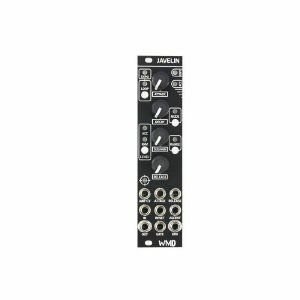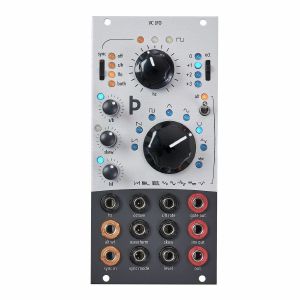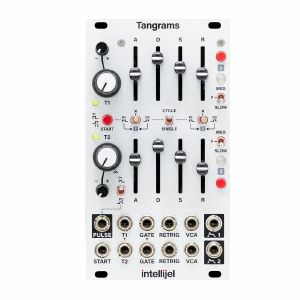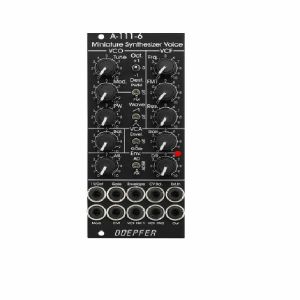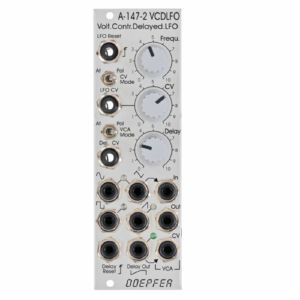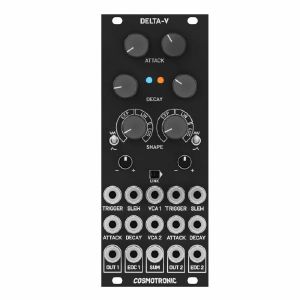Filter
Equipment
Format
Featured
Price
Tags: LFO module
Products tagged as LFO module
Items 1 to 6 of 6 on page 1 of 1
WMD Javelin Expressive Envelope & Amplitude Controller Module (CV modulation/envelope generator/LFO/VCA synth module)
Cat: 784089 Rel: 15 Jul 20
ADSR envelope module with integrated VCA - 6HP.
Notes: Javelin is a module that is basically an ADSR envelope with integrated VCA. However, it has several features that make the module an expressive sound shaping tool.
Three level ranges determine the total amplitude of the envelope, additionally three different time ranges are integrated, which can be switched between.
The accent behaviour is also unique. If several gates are applied to the Accent input at the same time, the envelope rises slightly with each gate.
Features:
Attack-decay-sustain-release envelope
Integrated VCA
Unique accent behaviour for expressive sequences
Reset input
CV control over attack and release
Looping mode for LFO-like modulations
Mode switch for gate and trigger behaviour
Linear, moderate or steep exponential shape
Short hold in the peak of the attack for more punch
Power consumption: 93mA at +12V and 65mA at -12V
Depth: 38mm
HP : 6
… Read moreThree level ranges determine the total amplitude of the envelope, additionally three different time ranges are integrated, which can be switched between.
The accent behaviour is also unique. If several gates are applied to the Accent input at the same time, the envelope rises slightly with each gate.
Features:
Attack-decay-sustain-release envelope
Integrated VCA
Unique accent behaviour for expressive sequences
Reset input
CV control over attack and release
Looping mode for LFO-like modulations
Mode switch for gate and trigger behaviour
Linear, moderate or steep exponential shape
Short hold in the peak of the attack for more punch
Power consumption: 93mA at +12V and 65mA at -12V
Depth: 38mm
HP : 6
2 in stock $264.23
Click for better price!
or call +44 20 7424 1960
quote 784089
quote 784089
Thorn Audio VC LFO Voltage Controlled Low Frequency Oscillator Module (silver/black) (LFO synth module)
Cat: 832527 Rel: 02 Jul 21
Voltage controlled low frequency oscillator module - 12HP
Notes: A deep, comprehensive digital LFO offering 16 waveforms, sync, built-in VCA and more. All made even more powerful by the fact you can control every parameter via dedicated CV inputs.
Supplier's Notes:
Fully voltage controllable Eurorack format, externally syncable, 16 waveform low frequency oscillator with built-in VCA and sample & hold.
Powered by a socketed VCLFO10 IC from Electric Druid.
The core idea behind this module is all about control voltage. Hence all features are individually broken out to CV inputs, making the most use possible of the benefits of the digital wavetable oscillator. This means that the design is geared towards allowing hands-off control of all aspects and some concessions have been made to that effect.
Initial setup basically consists of connecting the power cable to the module and your bus. The cable has a slotted socket for correct orientation, but mind that the red stripe faces the white line on the edge of the pcb. The included screws are nylon in order to minimise rack-rash.
Tuning the module is possible by adjusting the small smd trim potentiometer on the back. It adjusts the offset voltage that affects the center point of the lfo oscillations. It should be close to its three o'clock position, but you can adjust it by turning the module on, reducing the output level to almost zero and turning the trim potentiometer until you find the point where the gate output led just barely turns off.
The LFO sync type is hard sync, meaning that it resets the current cycle to the beginning of the waveform. It does not control the duration of the cycles. This allows you to further shape the output to, say, three quarters of a sinewave by using external sync and adjusting the HZ knob so the duration of a cycle is just a little longer than the time between incoming sync pulses.
Color coded nuts indicate the type of jack, with gold representing Gate/Trigger input, black is +-5v CV inputs and red jacks are outputs.
The CV inputs are scaled down to +-2.5v and added/subtracted with the knob setting, meaning that to sweep the full range of the parameter with CV, the knob should be in center position. The inputs are clipped to the allowed range after mixing, so you can apply any eurorack voltage here.
The module's core processor is socketed, so using a simple PIC programmer and some basic Assembly knowledge you can modify its functionality to suit your needs.
The code is written by Electric Druid who supplies the chips preprogrammed.
Height: 3U (128.5mm)
Width: 12hp (60.6mm)
Depth from panel: 31mm
Depth total: 51mm
+12v: 80mA
-12v: 60mA
… Read moreSupplier's Notes:
Fully voltage controllable Eurorack format, externally syncable, 16 waveform low frequency oscillator with built-in VCA and sample & hold.
Powered by a socketed VCLFO10 IC from Electric Druid.
The core idea behind this module is all about control voltage. Hence all features are individually broken out to CV inputs, making the most use possible of the benefits of the digital wavetable oscillator. This means that the design is geared towards allowing hands-off control of all aspects and some concessions have been made to that effect.
Initial setup basically consists of connecting the power cable to the module and your bus. The cable has a slotted socket for correct orientation, but mind that the red stripe faces the white line on the edge of the pcb. The included screws are nylon in order to minimise rack-rash.
Tuning the module is possible by adjusting the small smd trim potentiometer on the back. It adjusts the offset voltage that affects the center point of the lfo oscillations. It should be close to its three o'clock position, but you can adjust it by turning the module on, reducing the output level to almost zero and turning the trim potentiometer until you find the point where the gate output led just barely turns off.
The LFO sync type is hard sync, meaning that it resets the current cycle to the beginning of the waveform. It does not control the duration of the cycles. This allows you to further shape the output to, say, three quarters of a sinewave by using external sync and adjusting the HZ knob so the duration of a cycle is just a little longer than the time between incoming sync pulses.
Color coded nuts indicate the type of jack, with gold representing Gate/Trigger input, black is +-5v CV inputs and red jacks are outputs.
The CV inputs are scaled down to +-2.5v and added/subtracted with the knob setting, meaning that to sweep the full range of the parameter with CV, the knob should be in center position. The inputs are clipped to the allowed range after mixing, so you can apply any eurorack voltage here.
The module's core processor is socketed, so using a simple PIC programmer and some basic Assembly knowledge you can modify its functionality to suit your needs.
The code is written by Electric Druid who supplies the chips preprogrammed.
Height: 3U (128.5mm)
Width: 12hp (60.6mm)
Depth from panel: 31mm
Depth total: 51mm
+12v: 80mA
-12v: 60mA
2 in stock $202.31
Intellijel Tangrams Dual Analogue Core-Envelope Module (clock generator/CV modulation/envelope generator/function generator/LFO/VCA synth module)
Cat: 962200 Rel: 04 Aug 23
Dual ADSR/VCA module with cycling gate pulsers - 14HP.
Notes: Tangrams
Push (or Pulse) the Envelope
Snappy, classically analogue envelopes with visually intuitive controls. Add a powerful, cv controllable cyclical gate generator, integrated VCA, and trigger buttons -then double it-now you've got Tangrams.
Tangrams, like the Dual ADSR before it, is a dual analogue core-envelope inspired by the Roland SH-101 / System 100m design with several enhancements. Taking further inspiration from trapezoidal function generators like the one on the EMS Synthi, Intellijel have added a voltage-controlled pulser circuit to link the triggering of two envelopes - allowing for delayed one-shots, cycling organic envelopes, and more. In addition, Intellijel added two VCAs for level control of each envelope, or alternatively, direct injection of the signal you'd like to envelope - freeing up your other VCAs.
The Pulser
The Pulser can be thought of as a way to set both a gate ON time (T1) and an OFF time (T2). In this way, you could configure a cycling ADSR that has a gate time that is different from the interval between gates. Alternatively, you can create a sequence where ADSR2 is triggered by a delayed amount of time after ADSR1 is triggered (either cyclically or in a single shot sequence). The panel switches for routing or disabling the pulse sources allow for even more complex combinations of control beyond these examples. This special combination of functions can yield a plethora of interesting and organic envelope and gate patterns to be created; cyclical and single shot.
ADSR + VCA Features
Dual Analogue ADSR envelopes with digital gate Pulser for trapezoid shapes
Pulser stages P1 and P2 can be selectively routed to trigger each ADSR via panel switches
Three timing ranges: (FAST: ~5 seconds, MED: ~35sec, SLOW: ~1min A/D times)
Retrig input (allows re-triggering of the envelope if source gate held high)
VCA input can be used to dynamically control the respective ADSR output level (bipolar) or to process signals to be modulated in amplitude by the ADSR.
Manual GATE buttons for each envelope
Pulser Features
A pulse is made of individually controllable T1 and T2 stage lengths
CV control over T1 and T2 time
Pulser can be one-shot (SINGLE) or repeating (CYCLE)
PULSE output has a switch to select P1 or P2 as the source.
Pulser stages P1 and P2 can be selectively routed to trigger each ADSR via panel switches
START trigger input for starting/restarting the Pulser sequence
Manual GATE button to trigger the Pulser sequence
Size: 14HP
Depth: 35mm
Power: 66mA @ +12V 49mA @ -12V
… Read morePush (or Pulse) the Envelope
Snappy, classically analogue envelopes with visually intuitive controls. Add a powerful, cv controllable cyclical gate generator, integrated VCA, and trigger buttons -then double it-now you've got Tangrams.
Tangrams, like the Dual ADSR before it, is a dual analogue core-envelope inspired by the Roland SH-101 / System 100m design with several enhancements. Taking further inspiration from trapezoidal function generators like the one on the EMS Synthi, Intellijel have added a voltage-controlled pulser circuit to link the triggering of two envelopes - allowing for delayed one-shots, cycling organic envelopes, and more. In addition, Intellijel added two VCAs for level control of each envelope, or alternatively, direct injection of the signal you'd like to envelope - freeing up your other VCAs.
The Pulser
The Pulser can be thought of as a way to set both a gate ON time (T1) and an OFF time (T2). In this way, you could configure a cycling ADSR that has a gate time that is different from the interval between gates. Alternatively, you can create a sequence where ADSR2 is triggered by a delayed amount of time after ADSR1 is triggered (either cyclically or in a single shot sequence). The panel switches for routing or disabling the pulse sources allow for even more complex combinations of control beyond these examples. This special combination of functions can yield a plethora of interesting and organic envelope and gate patterns to be created; cyclical and single shot.
ADSR + VCA Features
Dual Analogue ADSR envelopes with digital gate Pulser for trapezoid shapes
Pulser stages P1 and P2 can be selectively routed to trigger each ADSR via panel switches
Three timing ranges: (FAST: ~5 seconds, MED: ~35sec, SLOW: ~1min A/D times)
Retrig input (allows re-triggering of the envelope if source gate held high)
VCA input can be used to dynamically control the respective ADSR output level (bipolar) or to process signals to be modulated in amplitude by the ADSR.
Manual GATE buttons for each envelope
Pulser Features
A pulse is made of individually controllable T1 and T2 stage lengths
CV control over T1 and T2 time
Pulser can be one-shot (SINGLE) or repeating (CYCLE)
PULSE output has a switch to select P1 or P2 as the source.
Pulser stages P1 and P2 can be selectively routed to trigger each ADSR via panel switches
START trigger input for starting/restarting the Pulser sequence
Manual GATE button to trigger the Pulser sequence
Size: 14HP
Depth: 35mm
Power: 66mA @ +12V 49mA @ -12V
6 in stock $252.06
Click for better price!
or call +44 20 7424 1960
quote 962200
quote 962200
Doepfer A-111-6v Miniature Synthesiser Voice Vintage Edition Module (black) (synth voice synth module)
Cat: 749811 Rel: 15 Nov 19
Complete miniature monophonic synthesiser module - 10HP
Notes: VCO:
- Tune: manual tune control (with an internal jumper the range can be set to ~ +/-1 half an octave or ~ +/-2.5 octaves)
- Oct: range switch -1 / 0 / +1 octave
- Mod: modulation depth (attenuator wired to the Mod. socket)
- Dest: switch that is used to address the modulation to frequency modulation (position FM) or pulsewidth modulation (positon PM), in centre positon no modulation
- PW: manual pulsewidth control for rectangle waveform, PW can be also modulated by the Mod. input as mentioned above
- Wave: waveform switch (sawtooth / off / triangle), the sum of the waveform chosen by this switch and the rectangle is fed into the VCF (to turn the rectangle off the PW control has to be set fully CCW or fully CW)
- 1V/Oct. (socket): external CV input for VCO frequency (1V/octave)
- Access to internal bus CV (via jumper, optional, please remove the bus jumper if this feature is not used to avoid unwanted frequency modulation as then the unused CV line of the bus works as a kind of antenna)
- Triangle core VCO, frequency range about 32Hz ... 8kHz
Balance unit:
- The balance unit is made of two VCAs which are controlled by the sum of manual Balance control and the balance CV input in the opposite direction.
- The audio input of VCA1 is hard-wired to the VCO output, audio input 2 is connected to the socket Ext.In.
- The output of the balance unit is used as audio input for the VCF
- Bal.: manual balance control, fully CCW the internal VCO is used, fully CW the external signal (Ext.In) is used, at centre position both signals have about the same level
- CV Bal.: CV input for balance (range about 0...+5V)
- Ext. In: external audio input for VCA2, about 5 Vpp level required for similar loudness as the internal VCO
- This socket is normalled to the internal VCO suboctave f/2 signal (rectangle with half the frequency), if no external signal is applied the suboctave signal is used as the second signal for the balance unit
VCF:
- 24 dB low pass
- Frq: manual frequency control
- FM1: frequency modulation depth (attenuator wired to the VCF FM1 socket, the socket is normalled to the internal Envelope signal and then FM1 controls the modulation depth of the internal envelope applied to the filter)
- FM2 (socket) : second CV input for VCF without attenuator (about 1V/octave), can be used e.g. for VCF tracking by connecting the same CV which is used also for the VCO frequency
- Res: manual resonance control (up to self oscillation)
- If the VCO is turned off (waveform switch = centre position, pulsewidth control = fully CCW or CW) and the VCF resonance is set to maximum the module can be used as a sine oscillator, the tracking at socket VCF FM2 is about 1V/octave (not as precise as the VCO but much better than most other filters)
- ~ 11 octaves frequency range (~ 10 Hz ... 20kHz)
VCA:
- Gain: manual amplitude control (initial gain), can be used to open the VCA without envelope signal
- VCA (switch): used to switch between gate and envelope as control signal for the VCA, in centre position the VCA is not controlled by envelope or gate
- Note: when gate is used the VCA is controlled directly by the gate signal (i.e. hard on/off), this may lead to clicking noise under certain conditions (especially with low VCO/VCF frequencies)
- Special control scale: exponential scale in the range from about -20dB to -80/90dB, linear scale from about -20dB to 0dB
- Remark: this special control scale results in a loudness behaviour that is a bit different from pure linear or exponential VCAs
- Out: audio output of the module (= VCA output)
Envelope:
- Gate (socket): Gate input (min. +5V), can be normalled to the bus gate signal by means of a jumper
- Att: manual control for Attack
- D/R: manual control for Decay/Release
- Env. (switch): used to switch between A/D, ADSR and A/R mode of the envelope generator, in centre position (ADSR) the sustain level is fixed to about 50%
- Envelope (socket): envelope output (about +10V)
- CVT (socket): CV input for time control, by means of two internal jumpers one can select which time parameters are controlled by the CVT input (e.g. A only or D/R only or A/D/R) and in which direction (i.e. if an increasing CVT shortens or stretches the time parameter in question)
- Envelope LED display
- Attack time range: ~ 1ms ... 5 sec (can be extended by using the CVT input)
- Decay/Release time range: ~ 1ms ... 15 sec (can be extended by using the CVT input)
… Read more- Tune: manual tune control (with an internal jumper the range can be set to ~ +/-1 half an octave or ~ +/-2.5 octaves)
- Oct: range switch -1 / 0 / +1 octave
- Mod: modulation depth (attenuator wired to the Mod. socket)
- Dest: switch that is used to address the modulation to frequency modulation (position FM) or pulsewidth modulation (positon PM), in centre positon no modulation
- PW: manual pulsewidth control for rectangle waveform, PW can be also modulated by the Mod. input as mentioned above
- Wave: waveform switch (sawtooth / off / triangle), the sum of the waveform chosen by this switch and the rectangle is fed into the VCF (to turn the rectangle off the PW control has to be set fully CCW or fully CW)
- 1V/Oct. (socket): external CV input for VCO frequency (1V/octave)
- Access to internal bus CV (via jumper, optional, please remove the bus jumper if this feature is not used to avoid unwanted frequency modulation as then the unused CV line of the bus works as a kind of antenna)
- Triangle core VCO, frequency range about 32Hz ... 8kHz
Balance unit:
- The balance unit is made of two VCAs which are controlled by the sum of manual Balance control and the balance CV input in the opposite direction.
- The audio input of VCA1 is hard-wired to the VCO output, audio input 2 is connected to the socket Ext.In.
- The output of the balance unit is used as audio input for the VCF
- Bal.: manual balance control, fully CCW the internal VCO is used, fully CW the external signal (Ext.In) is used, at centre position both signals have about the same level
- CV Bal.: CV input for balance (range about 0...+5V)
- Ext. In: external audio input for VCA2, about 5 Vpp level required for similar loudness as the internal VCO
- This socket is normalled to the internal VCO suboctave f/2 signal (rectangle with half the frequency), if no external signal is applied the suboctave signal is used as the second signal for the balance unit
VCF:
- 24 dB low pass
- Frq: manual frequency control
- FM1: frequency modulation depth (attenuator wired to the VCF FM1 socket, the socket is normalled to the internal Envelope signal and then FM1 controls the modulation depth of the internal envelope applied to the filter)
- FM2 (socket) : second CV input for VCF without attenuator (about 1V/octave), can be used e.g. for VCF tracking by connecting the same CV which is used also for the VCO frequency
- Res: manual resonance control (up to self oscillation)
- If the VCO is turned off (waveform switch = centre position, pulsewidth control = fully CCW or CW) and the VCF resonance is set to maximum the module can be used as a sine oscillator, the tracking at socket VCF FM2 is about 1V/octave (not as precise as the VCO but much better than most other filters)
- ~ 11 octaves frequency range (~ 10 Hz ... 20kHz)
VCA:
- Gain: manual amplitude control (initial gain), can be used to open the VCA without envelope signal
- VCA (switch): used to switch between gate and envelope as control signal for the VCA, in centre position the VCA is not controlled by envelope or gate
- Note: when gate is used the VCA is controlled directly by the gate signal (i.e. hard on/off), this may lead to clicking noise under certain conditions (especially with low VCO/VCF frequencies)
- Special control scale: exponential scale in the range from about -20dB to -80/90dB, linear scale from about -20dB to 0dB
- Remark: this special control scale results in a loudness behaviour that is a bit different from pure linear or exponential VCAs
- Out: audio output of the module (= VCA output)
Envelope:
- Gate (socket): Gate input (min. +5V), can be normalled to the bus gate signal by means of a jumper
- Att: manual control for Attack
- D/R: manual control for Decay/Release
- Env. (switch): used to switch between A/D, ADSR and A/R mode of the envelope generator, in centre position (ADSR) the sustain level is fixed to about 50%
- Envelope (socket): envelope output (about +10V)
- CVT (socket): CV input for time control, by means of two internal jumpers one can select which time parameters are controlled by the CVT input (e.g. A only or D/R only or A/D/R) and in which direction (i.e. if an increasing CVT shortens or stretches the time parameter in question)
- Envelope LED display
- Attack time range: ~ 1ms ... 5 sec (can be extended by using the CVT input)
- Decay/Release time range: ~ 1ms ... 15 sec (can be extended by using the CVT input)
1 in stock $207.84
Doepfer A-147-2 Voltage Controlled Delayed Low Frequency Oscillator Module (silver) (envelope generator/LFO/VCA/CV modulation synth module)
Cat: 671585 Rel: 29 Nov 17
Module consisting of voltage-controlled low frequency oscillator (LFO) & voltage controlled amplifier (VCA) - 8HP
Notes: Module A-147-2 is the successor of the VCLFO A-147 but offers much more features than the predecessor. The module is made of these sub-units:
- VCLFO: voltage controlled low frequency oscillator
- VCA: voltage controlled amplifier, switchable to voltage controlled polarizer
- VC delay unit: voltage controlled linear attack envelope (only one parameter: attack) for delayed LFO operation in combination with the VCA (e.g. delayed vibrato/tremolo)
LFO: The voltage controlled LFO has the waveforms Triangle, Sine, Sawtooth and Rectangle available and features a Reset/Sync input. Triangle/Sine and Rectangle are displayed by means of dual-colour LEDs (probably red/green), Sawtooth has a unicolor LED available (probably blue). The output levels are about -4V...+4V for Triangle, Sine and Rectangle. The Sawtooth level is about 0...+8V.
The CV control can be switched to attenuator or polarizer ("CV Mode" switch). In polarizer mode the CV inputs affects the frequency in the reverse manner when the CV control is left from the centre position. In the centre position CV has no effect and right from the centre the control works like a normal attenuator. The frequency range (without external CV) is from about 0,005 Hz (i.e. about 3 minutes per period) to 200 Hz (with external CV max. frequency about 1kHz). In addition a ultra-low mode can be activated by means of an internal jumper. When the ultra-low jumper is set a fixed voltage is connected to the switching contact of the "LFO CV" socket. In polarizer mode of the CV control that way extremely low frequencies (up to one hour period and more) are possible. For this a jumper has to be installed on the pin header JP6. In the factory a dummy jumper is installed on the pin header JP7 "Dummy". JP7 has no function and is used only for "parking" of the jumper. Simply remove the jumper from JP7 and plug it on JP6. JP6 is located behind the CV control.
VCA: This is a linear VCA that can be switched to "normal" VCA (i.e. kind of a voltage controlled attenuator) or voltage controlled polarizer ("VCA Mode" switch). In the "normal" VCA mode amplification +1 is achieved with about +5V control voltage. In polarizer mode the amplification ranges from about -0.5 (i.e. inverted signal with about 50% level) with 0V CV to +0.5 (i.e. non-inverted signal with about 50% level) with +5V CV. With about +2.5V CV the signal is suppressed. Details about the functioning of a voltage controlled polarizer can be found in the description of the module A-133. In this mode the VCA can be treated also a DC coupled ring modulator (similar to A-114).
The VCA of the A-147-2 has three sockets available: "In" (signal input), "Out" (signal output) and "CV" (control voltage input).
The Triangle Output of the LFO is normalled to the VCA signal input by means of the switching contact of the "VCA In" socket. If another LFO waveform (or any other signal) should be processed by the VCA the corresponding signal has to be patched to the "VCA In" socket. The VCA can be used also independently from the LFO and the Delay CV. In this case the VCA sockets In, Out and CV have to be patched accordingly. The VCA can be used also as waveshaper for the LFO signals (e.g. by patching VCA In and VCA CV to different LFO signals, if necessary via attenuator A-183-1 or offset generator/attenuator A-183-2).
Attack/Delay: The third sub-unit of the module is a simple, voltage controlled envelope generator that has only the parameter "Delay" (or Attack) available. This unit generates a linear increasing voltage that starts from 0V after each Delay Reset until it reaches about +5V. Then the voltage remains at +5V until the next Delay Reset occurs. The inclination or gradient is controlled by the manual Delay control and the Delay control voltage ("Delay CV" input). The waveform is linear, the control scale is exponential. The output voltage is displayed by a green LED and available at the "Delay Out" socket.
The manual Delay control ranges - without external "Delay CV" - from about 5ms (fully CW) up to 2 minutes (fully CCW). By means of an external voltage applied to the "Delay CV" socket this range can be extended. A rising CV shortens the delay time (behaviour like a VCO)!
The Delay output voltage ranges from about 0V to +5V. The rising edge of the gate, clock or trigger signal applied to the "Delay Reset" sockets resets the Delay output voltage to 0 V.
"Delay Out" is normalled to the VCA CV input by means of the switching contact of the "VCA CV" socket and consequently controls the Triangle level provided that no other patch is made. A typical example is the usage of a Gate signal (e.g. from a USB/Midi-to-CV/Gate interface) as Delay Reset. That way a delayed vibrato or tremolo can be realized if the VCA output is patched to the frequency CV input of a VCO (or VCF), or the CV input of a VCA.
… Read more- VCLFO: voltage controlled low frequency oscillator
- VCA: voltage controlled amplifier, switchable to voltage controlled polarizer
- VC delay unit: voltage controlled linear attack envelope (only one parameter: attack) for delayed LFO operation in combination with the VCA (e.g. delayed vibrato/tremolo)
LFO: The voltage controlled LFO has the waveforms Triangle, Sine, Sawtooth and Rectangle available and features a Reset/Sync input. Triangle/Sine and Rectangle are displayed by means of dual-colour LEDs (probably red/green), Sawtooth has a unicolor LED available (probably blue). The output levels are about -4V...+4V for Triangle, Sine and Rectangle. The Sawtooth level is about 0...+8V.
The CV control can be switched to attenuator or polarizer ("CV Mode" switch). In polarizer mode the CV inputs affects the frequency in the reverse manner when the CV control is left from the centre position. In the centre position CV has no effect and right from the centre the control works like a normal attenuator. The frequency range (without external CV) is from about 0,005 Hz (i.e. about 3 minutes per period) to 200 Hz (with external CV max. frequency about 1kHz). In addition a ultra-low mode can be activated by means of an internal jumper. When the ultra-low jumper is set a fixed voltage is connected to the switching contact of the "LFO CV" socket. In polarizer mode of the CV control that way extremely low frequencies (up to one hour period and more) are possible. For this a jumper has to be installed on the pin header JP6. In the factory a dummy jumper is installed on the pin header JP7 "Dummy". JP7 has no function and is used only for "parking" of the jumper. Simply remove the jumper from JP7 and plug it on JP6. JP6 is located behind the CV control.
VCA: This is a linear VCA that can be switched to "normal" VCA (i.e. kind of a voltage controlled attenuator) or voltage controlled polarizer ("VCA Mode" switch). In the "normal" VCA mode amplification +1 is achieved with about +5V control voltage. In polarizer mode the amplification ranges from about -0.5 (i.e. inverted signal with about 50% level) with 0V CV to +0.5 (i.e. non-inverted signal with about 50% level) with +5V CV. With about +2.5V CV the signal is suppressed. Details about the functioning of a voltage controlled polarizer can be found in the description of the module A-133. In this mode the VCA can be treated also a DC coupled ring modulator (similar to A-114).
The VCA of the A-147-2 has three sockets available: "In" (signal input), "Out" (signal output) and "CV" (control voltage input).
The Triangle Output of the LFO is normalled to the VCA signal input by means of the switching contact of the "VCA In" socket. If another LFO waveform (or any other signal) should be processed by the VCA the corresponding signal has to be patched to the "VCA In" socket. The VCA can be used also independently from the LFO and the Delay CV. In this case the VCA sockets In, Out and CV have to be patched accordingly. The VCA can be used also as waveshaper for the LFO signals (e.g. by patching VCA In and VCA CV to different LFO signals, if necessary via attenuator A-183-1 or offset generator/attenuator A-183-2).
Attack/Delay: The third sub-unit of the module is a simple, voltage controlled envelope generator that has only the parameter "Delay" (or Attack) available. This unit generates a linear increasing voltage that starts from 0V after each Delay Reset until it reaches about +5V. Then the voltage remains at +5V until the next Delay Reset occurs. The inclination or gradient is controlled by the manual Delay control and the Delay control voltage ("Delay CV" input). The waveform is linear, the control scale is exponential. The output voltage is displayed by a green LED and available at the "Delay Out" socket.
The manual Delay control ranges - without external "Delay CV" - from about 5ms (fully CW) up to 2 minutes (fully CCW). By means of an external voltage applied to the "Delay CV" socket this range can be extended. A rising CV shortens the delay time (behaviour like a VCO)!
The Delay output voltage ranges from about 0V to +5V. The rising edge of the gate, clock or trigger signal applied to the "Delay Reset" sockets resets the Delay output voltage to 0 V.
"Delay Out" is normalled to the VCA CV input by means of the switching contact of the "VCA CV" socket and consequently controls the Triangle level provided that no other patch is made. A typical example is the usage of a Gate signal (e.g. from a USB/Midi-to-CV/Gate interface) as Delay Reset. That way a delayed vibrato or tremolo can be realized if the VCA output is patched to the frequency CV input of a VCO (or VCF), or the CV input of a VCA.
1 in stock $130.71
Cosmotronic Delta-V Dual Amped Envelope Generator Module (black) (CV modulation/envelope generator/LFO/polarizer/slew limiter/utility/VCA synth module)
Cat: 803494 Rel: 20 May 21
CV modulation/envelope generator/LFO/polariser/slew limiter/utility/VCA module
Notes: Delta-V is a fully analogue dual-channel function generator, featuring a dedicated VCA and LFO cycle switch for each channel. It packs a great deal of functionality in only 10HP, and will surely find use in almost every patch.
Generate envelopes, slew gates and signals, or run LFOs with precise control over attack and decay times. Using the SHAPE knob, Delta-v can create a wide range of envelopes, from very snappy exponential curves for percussion to logarithmic thumps for bass lines.
If VCA's input is unpatched, the module outputs a regular voltage envelope. When an audio signal is patched into the VCA input, the output signal becomes the audio signal amplified by the envelope.
Sending other envelopes or an LFO to VCA input lets you modulate those modulators, quickly creating complex control voltages that go beyond the usual attack-decay envelope.
Combine this with the SUM output, which sums the two channels, and the attenuverters, which can quickly attenuate or invert the signal, and you have a whole array of signal processing capabilities.
The TRIGGER input fires a Attack-Decay envelope, while the SLEW input will affect the rate of change of the signal.
The trigger for channel 1 and 2 can be linked together, so you can fire two envelopes with one patch cable.
Each channel has an End of Cycle output, (EOC) this outputs a short trigger at the end of each envelope cycle.
The output voltage ranges from -10 to +10 volts, set with handy output attenuverters.
The CYCLE switch starts looping the envelope, creating LFO's that go up to audio rate, and that can also be used as an interesting sound source.
There are many ways to utilise Delta-V.
Challenge yourself to explore new, unconventional territories!
Width: 10HP
Depth: 27MM
Power: +12V 70 MA
Power: -12V 70 MA
Power 5V: 0 MA
… Read moreGenerate envelopes, slew gates and signals, or run LFOs with precise control over attack and decay times. Using the SHAPE knob, Delta-v can create a wide range of envelopes, from very snappy exponential curves for percussion to logarithmic thumps for bass lines.
If VCA's input is unpatched, the module outputs a regular voltage envelope. When an audio signal is patched into the VCA input, the output signal becomes the audio signal amplified by the envelope.
Sending other envelopes or an LFO to VCA input lets you modulate those modulators, quickly creating complex control voltages that go beyond the usual attack-decay envelope.
Combine this with the SUM output, which sums the two channels, and the attenuverters, which can quickly attenuate or invert the signal, and you have a whole array of signal processing capabilities.
The TRIGGER input fires a Attack-Decay envelope, while the SLEW input will affect the rate of change of the signal.
The trigger for channel 1 and 2 can be linked together, so you can fire two envelopes with one patch cable.
Each channel has an End of Cycle output, (EOC) this outputs a short trigger at the end of each envelope cycle.
The output voltage ranges from -10 to +10 volts, set with handy output attenuverters.
The CYCLE switch starts looping the envelope, creating LFO's that go up to audio rate, and that can also be used as an interesting sound source.
There are many ways to utilise Delta-V.
Challenge yourself to explore new, unconventional territories!
Width: 10HP
Depth: 27MM
Power: +12V 70 MA
Power: -12V 70 MA
Power 5V: 0 MA
3 in stock $217.79
Click for better price!
or call +44 20 7424 1960
quote 803494
quote 803494
Items 1 to 6 of 6 on page 1 of 1

 USD
USD





